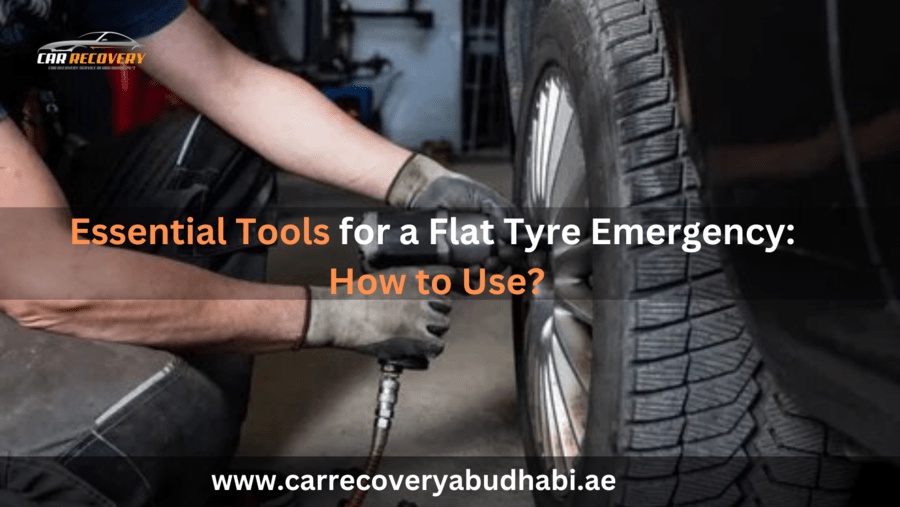It has happened to all of us at some point: you are cruising down the highway, running late for an important meeting, when suddenly you hear that dreaded flapping sound. Yes, we are talking about the flat tyre(s) that eventually lead to annoyance and getting late for important work. To avoid the stress of flat tyres having a set of essential tools for a flat tyre can swiftly get you back on the road. Here is what you should keep in your vehicle:
Essential Tools for a Flat Tyre: Quick fix, easy carry
Spare Tyre
First and foremost, having a spare tyre in your vehicle is essential. Ensure your spare tyre is properly inflated and has sufficient tread depth. Additionally, check the spare tyre’s condition regularly to ensure it is in good shape. If your vehicle does not have a spare tyre, consider investing in a compact temporary spare or a run-flat tyre. Even if you can’t change the flat tyre with a spare yourself, calling for flat tyre services Abu Dhabi to help you adjust the spare tyre is feasible. However, it all boils down to having the spare tyre in your car at all times. Further, if you don’t have a spare tyre, it is better to inform the service you call with your car details so they can arrange it beforehand.
Tyre Jack
When changing a flat tyre, a tyre jack is a crucial tool to have. It is essential for lifting your vehicle off the ground, providing access to the flat tyre, and allowing you to replace it with the spare. Ensure that your tyre jack suits your vehicle’s weight and is in good working condition. However, it’s also essential to know the proper jacking points on your vehicle to avoid any potential damage.
Lug Wrench
A lug wrench is also known as a tyre iron. It removes and replaces the lug nuts securing the flat tyre to the vehicle. So, having the right size lug wrench for your vehicle is crucial, typically specified in your owner’s manual. Ensure you use a sturdy wrench to withstand the torque required to loosen the lug nuts. Moreover, many lug wrenches also come with a telescoping handle for added leverage.
Reflective Safety Vest and Warning Triangles
A reflective safety vest and warning triangles can ensure your safety while changing a flat tyre, especially if you’re on a busy road or highway. Hence, these items make you more visible to other drivers, reducing the risk of accidents. Wearing a reflective safety vest helps drivers see you from a distance. On the other hand, warning triangles provide a clear signal to approaching vehicles that there is a hazard ahead.
Flashlight and Batteries
A flat tyre can happen anytime, at night, or in low-light conditions. Having a flashlight and extra batteries in your emergency toolkit is crucial for illuminating the area around your vehicle. Furthermore, this will make it easier to see and work on changing the tyre. It is ensuring your safety throughout the process.
Gloves and a Mat
In addition to the above essential tools for a flat tyre, having a pair of gloves and a mat in your emergency kit is a good idea. It is because gloves protect your hands from dirt, grime, and potential injuries while handling the tyre and tools. Furthermore, a mat or kneeling pad will provide a comfortable surface to sit or kneel on. It is making the tyre-changing process more manageable.
Tyre Pressure Gauge
Although a tyre pressure gauge may not directly assist in changing a flat tyre, it’s still an essential tool. Thus, inflating your tyres is crucial for safe driving and preventing flat tyres. A tyre pressure gauge enables you to check the air pressure in your tyres regularly, ensuring they are within the recommended range. In brief, this tool will help you identify potential issues and avoid unnecessary flat tyres.
Portable Air Compressor
Sometimes, a flat tyre may be caused by low air pressure rather than a puncture. In these situations, having a portable air compressor can be incredibly helpful. Additionally, these compact devices allow you to inflate your tyre on the spot. Also, it saves you the hassle of changing the tyre altogether. Choose an air compressor with the appropriate power and compatibility for your vehicle’s tyres.
Tyre Sealant or Repair Kit
Along with a portable air compressor, carrying a tyre sealant or repair kit can be a game-changer when faced with a minor puncture. These products can temporarily seal small leaks and allow you to drive to a nearby service station or repair shop without changing the tyre immediately. However, use these solutions cautiously as temporary fixes; they may not offer a long-term solution. Nevertheless, for a temporary fix until you can get to a tyre shop Abu Dhabi, a tyre sealant can be a quick solution for small punctures.
Wheel Chocks
When changing a flat tyre, preventing your vehicle from rolling is crucial. Wheel chocks are sturdy blocks designed to be placed behind the wheels opposite the one being changed, helping secure your vehicle. Furthermore, these are especially important when changing a flat tyre on an incline or uneven surface. Always ensure the wheel chocks are in place before lifting the vehicle with the jack.
Penetrating Lubricant
Over time, lug nuts can become tightly stuck due to factors like corrosion. In such scenarios, a penetrating lubricant can come in handy. Applying the lubricant to the lug nuts and allowing them to soak for a few minutes can make it easier to loosen them with the lug wrench. Moreover, this can save you from struggling with stubborn lug nuts, preventing potential damage to the nuts or the wrench itself.
Wheel Lock Key (If Applicable)
If your vehicle has wheel locks, which are special lug nuts with unique patterns to deter theft, it is essential to keep the wheel lock key accessible. So, this key is needed to remove and install wheel locks during the tyre-changing process. Ensure the wheel lock key is stored safely within your vehicle, such as in the glove compartment or center console.
Owner’s Manual
Each vehicle has specific needs and procedures for changing a tyre. You should always keep the owner’s manual in the vehicle as it contains tailored instructions.
Steps for Using Essential Tools for a Flat Tyre
When you experience a flat tyre:
- Pull over safely and turn on your hazard lights.
- Put in the parking brake and place wheel wedges.
- Remove the hubcap, if present, and loosen the lug nuts with the lug wrench.
- Position the jack under the vehicle and raise it until the tyre is off the ground.
- Remove the lug nuts and restore the flat tyre with the spare.
- Screw up the lug nuts by hand before lowering the vehicle.
- Lower the vehicle and screw up the lug nuts securely with the wrench.
- Replace the hubcap, if applicable, and stow all equipment.
Conclusion!
Remember, having these essential tools for a flat tyre does not guarantee that changing it will be a breeze. However, they certainly increase your chances of resolving the issue efficiently and safely. Therefore, regularly check these tools to ensure they are in good condition. Additionally, always be mindful of your surroundings while working on a flat tyre.
Experiencing a flat tyre is never enjoyable, but having the right emergency tools can make a significant difference. Always keep these essential items in your vehicle, including a spare tyre, tyre jack, lug wrench, reflective safety vest, warning triangles, flashlight, gloves, mat, and a tyre pressure gauge. With these tools readily available, you will be able to handle unexpected flat tyres confidently and get back on the road in no time. In case of complex tyre issues, seeking help from a professional is advisable.
This content is taken on given link: https://www.ausadvisor.com/essential-tools-for-a-flat-tyre-emergency-how-to-use/


No comments yet